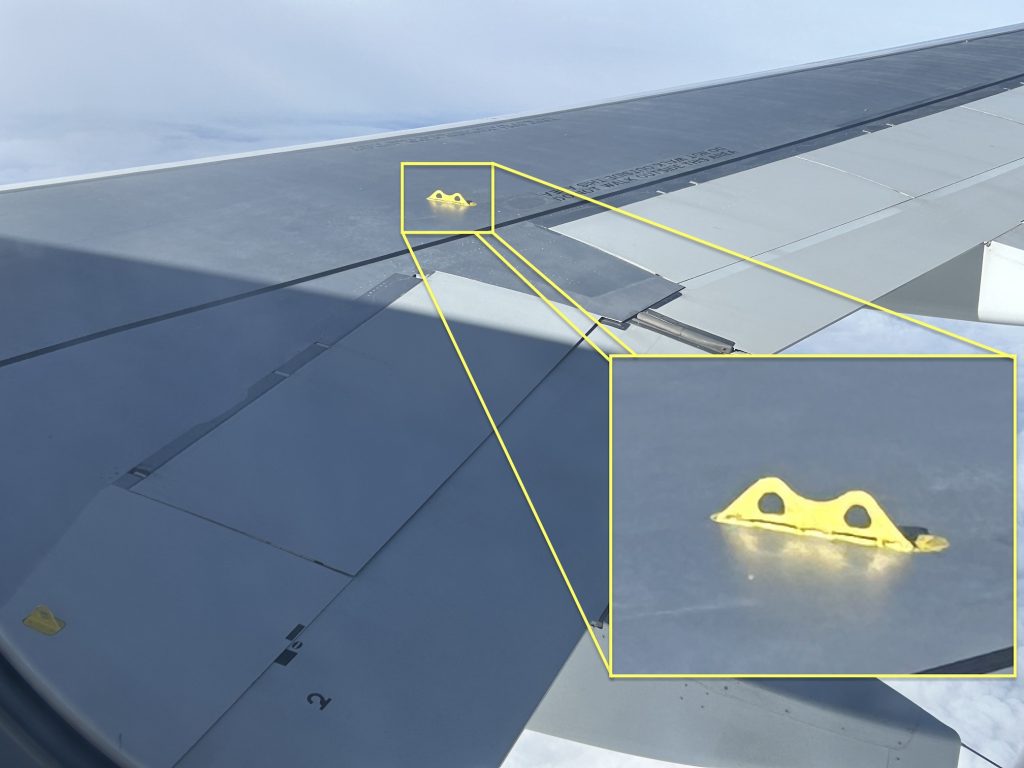Sometimes, as an aviation enthusiast and frequent flyer, you notice things that leave you puzzled. For me, one of those moments came when I looked out over the wing during a flight and spotted a small yellow object near the trailing edge. Too small to be a suspender for holding the wing, too singular to be part of a vortex generator array. The object featured two small holes, adding to the enigma.
What was this thing?

At first, I thought it might be some kind of aerodynamic feature. Vortex generators, perhaps? But no, vortex generators usually come in larger numbers and don’t have those odd little holes. Plus, they’re typically aligned in rows, and this lonely yellow thing sat in isolation.
Next, I thought it could be part of the anti-static system—a static wick holder maybe? That seemed more plausible. Static wicks help discharge static electricity from the plane’s surface, preventing interference with sensitive avionics. However, the location of this yellow object didn’t match the typical placement of static wicks, which are usually along the trailing edges. This little guy was too far forward.
Then, I considered whether it was a hinge for a blowout panel—used to relieve pressure in case of an emergency decompression. But the size and shape didn’t quite fit the bill for that, either.
After some digging (and a helpful hint from a friend), the mystery was solved: this yellow object was an over-wing evacuation rope guide!
In the event of an emergency where passengers need to exit via the over-wing exits, a rope is deployed to help them safely descend from the wing. The rope attaches to the wing using these small yellow guides, providing stability during evacuation. If the wing is slippery—due to rain, snow, or even in a water landing—these ropes give evacuees something to hold onto as they carefully make their way down. Without them, navigating off the wing could be quite precarious, especially under stressful conditions.
What’s fascinating about these small guides is that they are always painted yellow, regardless of the airline’s livery. Whether you’re flying Lufthansa, Austrian, or even EasyJet, you’ll notice that these little markers remain consistently yellow. This points to a standardization that likely stems from safety regulations, ensuring these critical points are easily identifiable no matter the airline’s color scheme. During an emergency, there’s no time for confusion, and the bright yellow makes sure everyone can spot them immediately.
This color standard is part of a broader approach in aviation where certain elements, especially those related to safety, remain uniform across airlines and aircraft types. Things like evacuation slides, escape path lighting, and even the over-wing exit signs follow strict guidelines to ensure passenger safety in emergencies. The over-wing evacuation rope guide is no exception.
The clues all fit. The size, shape, and location of the object suddenly made sense when viewed as a guide for the emergency rope system. Mystery solved!
So, next time you’re seated over the wing and see that little yellow marker, you can impress your fellow passengers with a fun fact about its critical role in aircraft safety. And remember, it’s yellow for a reason—because, in an emergency, clear and quick recognition can make all the difference.

Leave a Reply